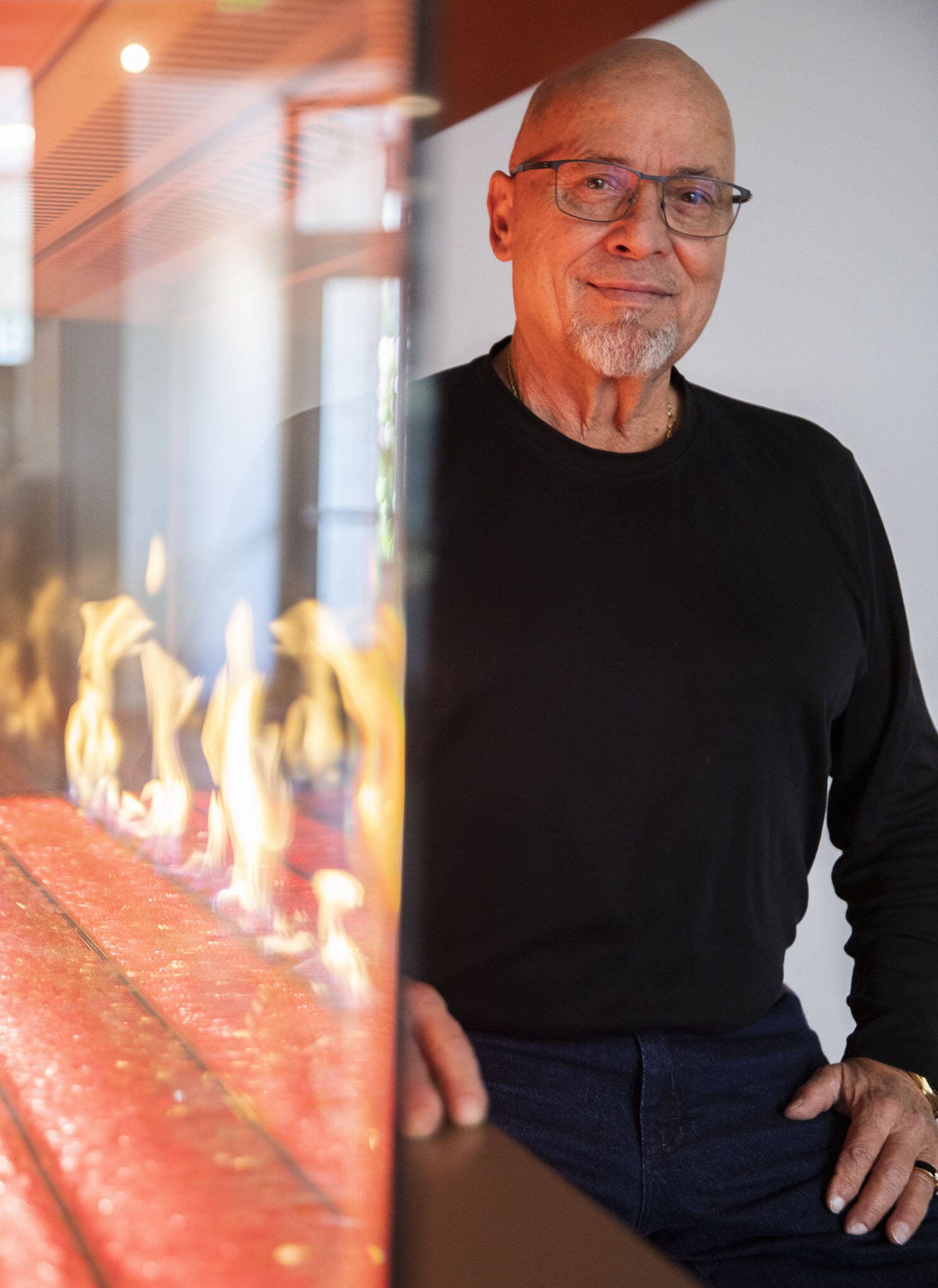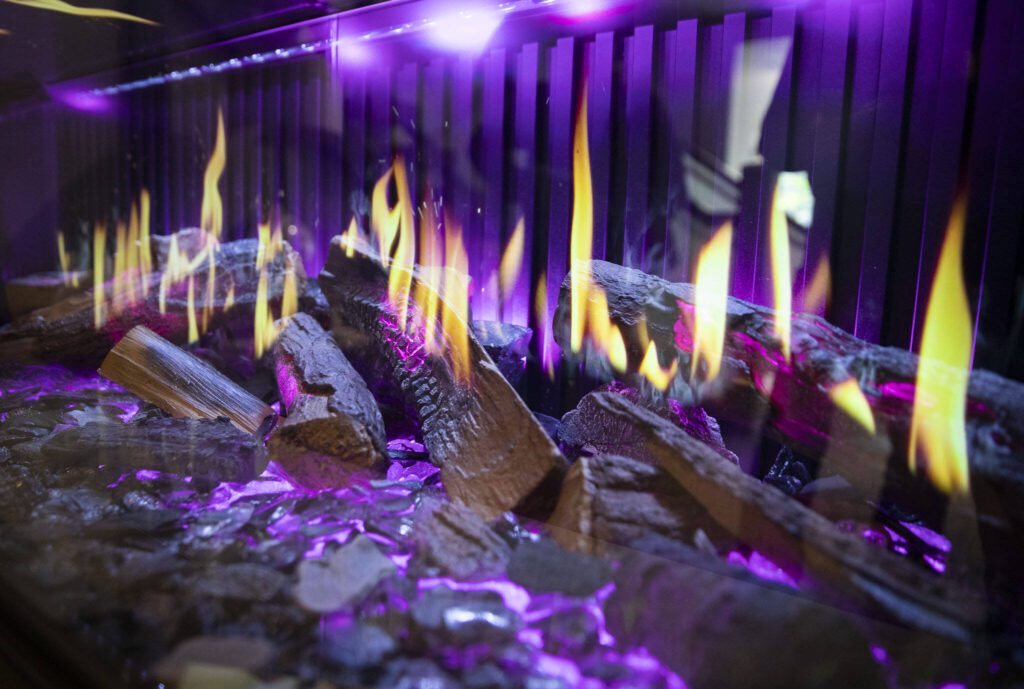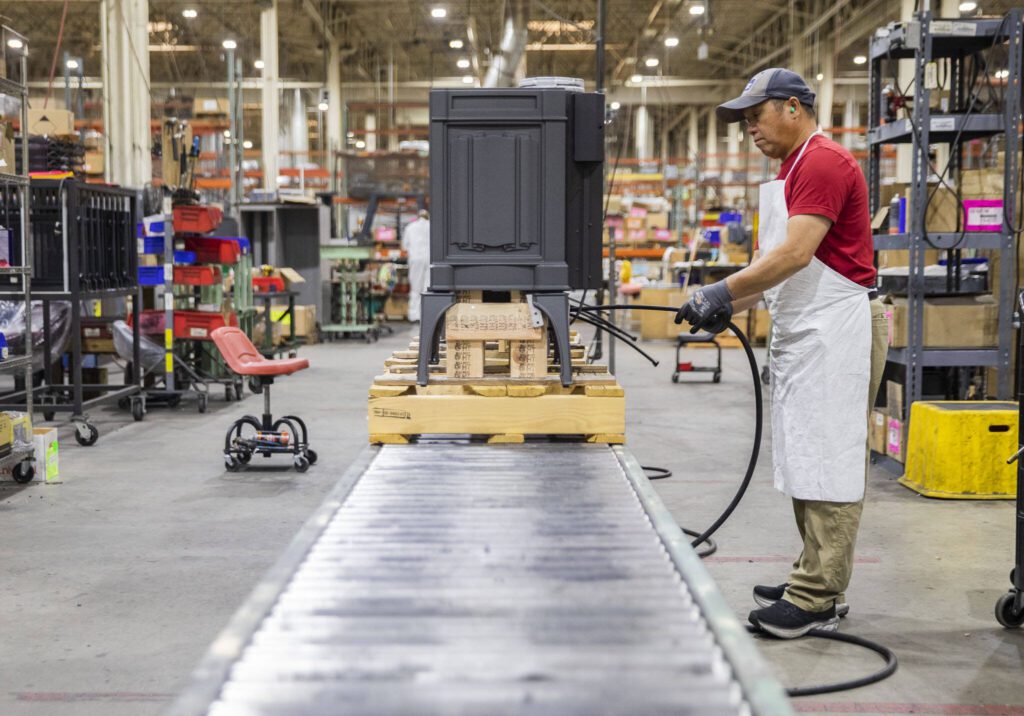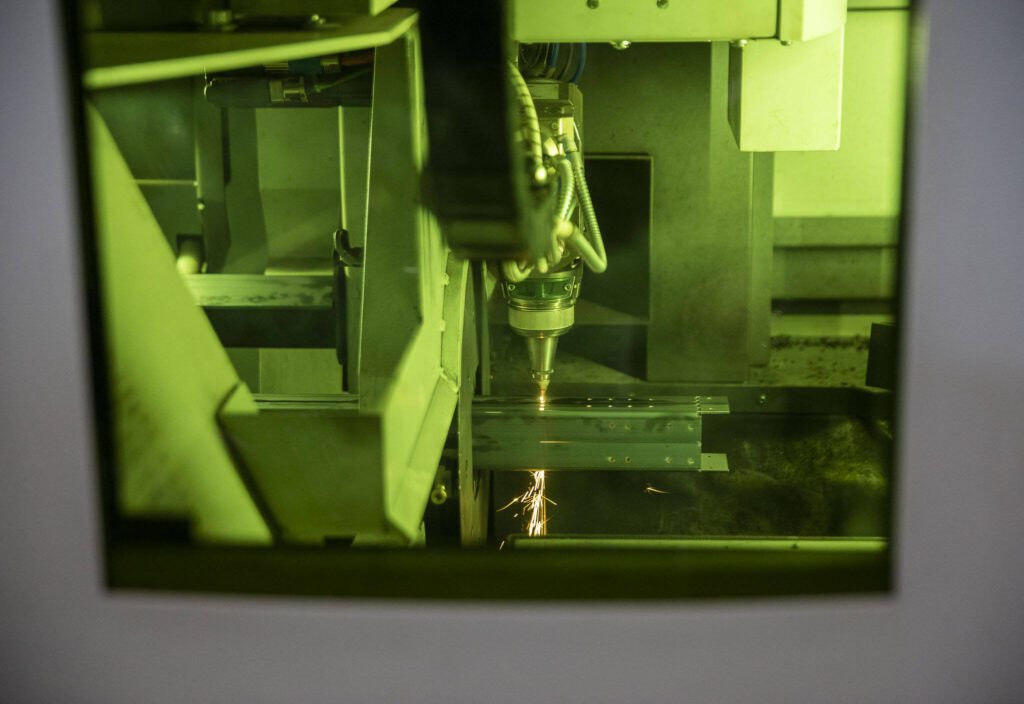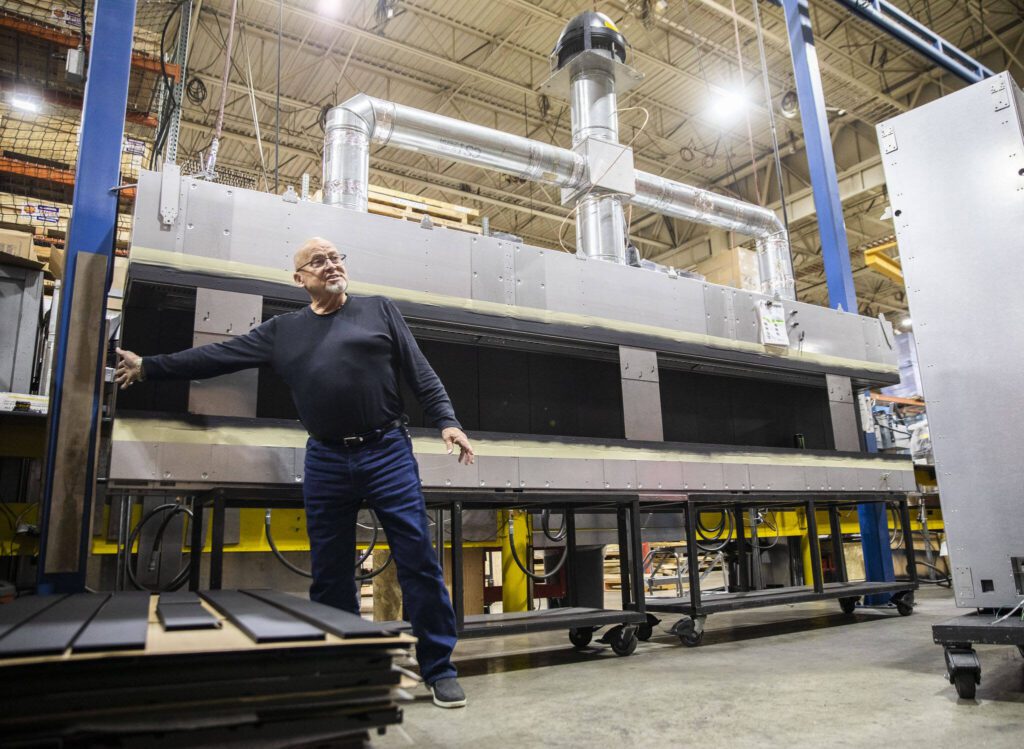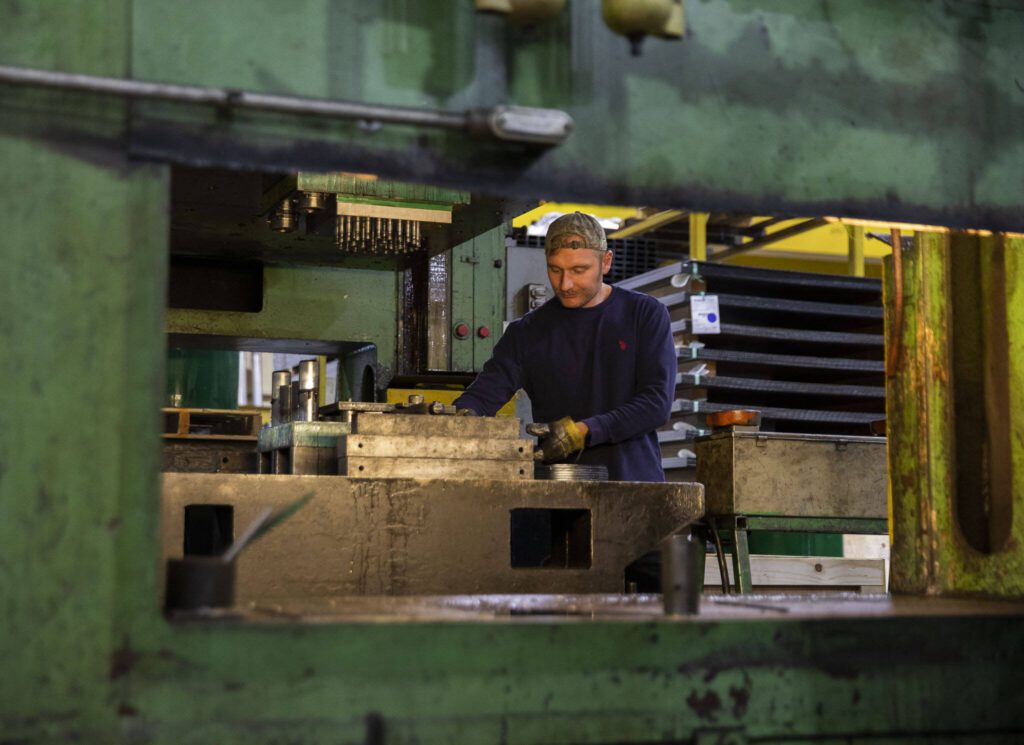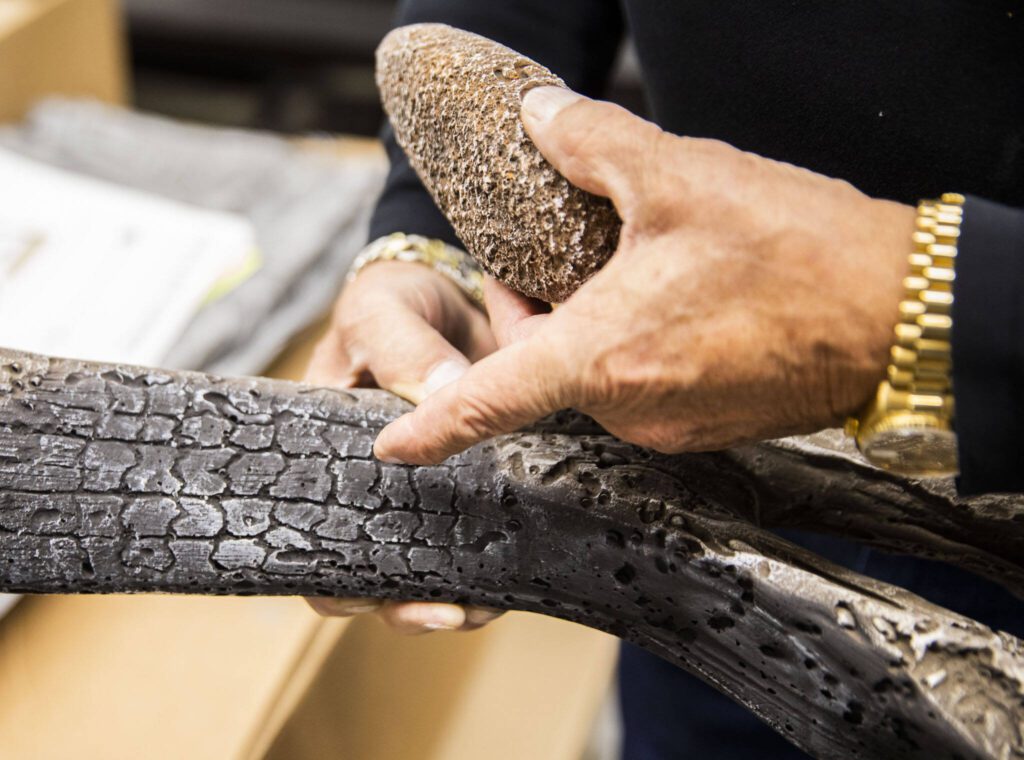From Monroe to Miami, there’s nothing like cozying up to a fire, whether it’s hot, cool or a hologram.
Wood stoves, pellet stoves, natural gas and electric fireplaces, Mukilteo’s Travis Industries makes them all.
“We sell fire in different forms,” said president and general manager Kurt Rumens, 70, who founded the business 45 years ago with one employee.
Today, it employs 450.
The Harbour Pointe plant sits on an 80-acre campus, dubbed the House of Fire. The wholesale company makes more than 40,000 fireplaces a year and racks up $150 million in annual sales with its four brands, Lopi, DaVinci, Xtrordinair and Fire Garden.
More than 800 retailers in North America and Australia carry Travis products. Custom buyers range from one of the nation’s largest pig farmers to the passenger terminal at Paine Field.
Record-breaking fireplaces
Travis Industries recently added a new log to its fire, creating the world’s longest gas fireplace, a 66-foot DaVinci hearth, for a Silicon Valley development.
“We tested it for six months,” Rumens said.
Clients include palace owners in Dubai — the company’s gas fired torches light the way — and Billionaires Row residents of Manhattan’s historic Crown Building, which boasts 148 custom Travis fireplaces.
Locally, Pokemon’s new Bellevue headquarters plans to install a Travis fireplace. The Harvest, a proposed mixed-use development in Woodinville, has ordered a dramatic 16-foot outdoor fireplace.
Customers waiting at Kendall Subaru cozy up to a Travis fireplace at the new dealership showroom in Marysville.
And if you’ve caught a commercial flight from Paine Field Airport, you’ve doubtless admired the passenger terminal’s two sleek centerpiece gas fireplaces.
“The fireplaces are beautiful,” said Thomas Amano, vice president of terminal operations with Propeller Airports, which built and operates the terminal. Passengers love them, he added.
“Both are ours,” Rumens said.
Factory tour
On a recent morning, we stopped in for a factory tour, offered every Thursday, registration required.
From the street, the complex at 12521 Harbour Reach Drive appears just another nondescript mega-warehouse. The main entrance, it turns out, is in the back.
“You can’t miss it,” a groundskeeper told us as we drove onto the sprawling campus. “Look for the bright red House of Fire sign and the flames,” he said.
Flaming glass lanterns, an outdoor fire garden and ornamental gates welcome visitors to the factory. The former Boeing plant spans 11 acres and offers a million square feet of production, research and office space.
Inside the foyer, an 8-foot fireplace supplies an immediate burst of warmth. The factory’s unofficial mascot Bella, a 15-year-old long-haired dachshund, can usually be found napping at the front desk.
Equipped with walkie-talkies and headsets — the factory can be LOUD — we gave our walking shoes a workout for an hour-long guided trek. But keep your eyes peeled, the busy fleet of three-wheeled bikes have the right of way.
Forklifts carrying supplies wend and beep their way through the aisles. Mallets clang against sheet metal. Two robot welders dubbed Romeo and Juliet sizzle and spark. Their names are an inside joke: Bolted to the floor and side by side, “the two will never meet,” Rumens said.
Above, ceiling cranes, a remnant of the building’s previous life as an aircraft interior assembly plant, stretch overhead. Air scrubbers hum continuously.
An enormous machine that resembles Arc de Triomphe in Paris is a Detroit transplant. Originally built to press out car bumpers in one fell swoop, the device is now used to stamp holes in heavy gauge steel. “When that thing operates you can hear it!” Rumens said.
Fiber optic lasers accurate to 10,000th of an inch have replaced old school punch presses.
“The same kind of technology they use to make airplanes, we now use to make fireplaces,” Rumens said.
Still, everything is hand fit and finished. Each woodstove and fireplace is tested before it rolls out the door.
Many workers have been there for 30 years or more. One stop on the tour is a huge poster showing them through the decades. There is Kurt Rumens in 1988, as he put it, “with a little more hair and a little less weight.”
“Kurt likes to promote from within,” said Jill Rumens, Kurt’s sister and the company’s architect representative.
For example, Alan Atemboski started as a welder. With his knack for design, he eventually became the director of research.
Rock-n-roll to riches
It’s a rock-n-roll to riches story. One of eight children, Kurt Rumens grew up in a home in Massachusetts where the only heat in his shared bedroom was from a wood stove.
“If you didn’t keep it stoked at night, you’d wake up with frost on the blanket,” he said.
In the mid-1970s, Rumens was an aspiring rock drummer, with a day job selling wood stoves.
On his way to hit it big in California, he stopped in Seattle when he ran out of gas.
He caught a glimpse of Mount Rainier and never left.
Wood stoves were all the rage. Their popularity soared during the ’70s oil embargo, driving petroleum prices up nearly 300%.
“The energy crisis was going on,” Rumens said. “America was crazy for wood heat.”
The cocky drummer believed he could build a better wood stove.
With $625 he launched Lopi, a “wolfish” sounding name he coined, in a Bellevue garage.
A few months later, he hauled the first model, a hefty 550-pounder, to the Evergreen State Fair in Monroe. It sold for $629.
Mukilteo bound or crossing Lake Washington
Lopi’s first production line was a 9,000-square-foot Kirkland warehouse.
By early 2000, Lopi, which became Travis Industries after its 1988 sale to Spokane manufacturer Travis Garske, occupied nearly 150,000 square feet. Rumens was asked to stay on for two months and find a new president.
“It’s 36 years later and I still haven’t found that son-of-a-bitch,” he said with a laugh. “Lopi was just a small wood stove company, Garske enabled all this.”
In the late 1990s, the company developed a natural gas fireplace. Its groundbreaking technology earned Travis Industries the Popular Science award for home improvement in 2000.
Low-temperature gas hearths, which offer flames without the high heat, are yet another innovation. Go ahead and touch the glass. It’s not much warmer than a puppy.
In 2003, Travis moved from Kirkland to a former Boeing plant in Mukilteo.
After leasing the space for 15 years, they bought the 80-acre property.
Fiery footprint
Travis Industries does not sell its products directly. Customers can find them at a retail dealer, such as Anderson Fireplace and Spas in Everett and Marysville.
“I patterned my dealership the way they pattern their company, in the way of taking care of your customers,” Anderson co-owner Kevin McBride said.
Standard gas fireplaces for homes start at about $6,000.
Travis is one of the largest industries in Mukilteo, yet one of its best kept secrets.
“They are tucked away. It’s funny, most people don’t know they are there,” Mukilteo Mayor Joe Marine said. “They have been very generous with the Chamber, hosting the car shows.”
During the COVID-19 pandemic, business boomed. With remote work and shelter at home orders, comfort ruled.
“People were staying home,” Rumens said. “They were tired of outdated furniture and appliances, tired of being cold.”
To meet demand, Travis went on a hiring spree. “We were up to 600 people during the Covid period,” he said.
Even the factory’s cafeteria picked up the pace, offering breakfast and lunch and sandwiches for workers on the third shift.
Custom fire
It takes six to eight weeks to build a custom fireplace. Obviously, the Silicon Valley 66-footer, the length of a bowling lane, took longer.
Details are important. Everyone agonizes over the aesthetics.
You might throw an armful of cord wood on the fire, but at Travis an in-house artist sculpts the fireplace logs to please the eye.
“Those are hand-carved logs,” Jill Rumens said. “We cast them, and then we hand paint them to make them look real.”
Small, insulated huts dot the factory floor.
Inside, wood stoves and fireplaces undergo destructive testing to determine what happens after 10,000 hours at 10 below zero. Think Minnesota in winter.
“It’s not simulated, it’s really cold,” Kurt Rumens said. “We want to make sure they can take the rigors of Lake Superior.”
A fiery future
This year, the company began making a new line of electric fireplaces.
Unlike some electric hearths that employ spinning refractors and LED lights, Travis uses computer-generated holograms to simulate fire, smoke, sparks and sputter.
Smoke and flames rise from the logs.
“You see a spark and hear a crackle,” Rumens said, pressing a remote that controls the height and color of the flames.
Holograms are one of the latest innovations in electric fireplace design.
For Rumens, a hologram of Michael Jackson singing and dancing was the spark.
Watching the King of Pop’s tribute show in Las Vegas, he wondered, “Why can’t we do this with fire?”
“We didn’t invent the technology, we just applied the technology to fire.”
Tour over, we turn toward the exit. A banner thanks us for visiting. Its glowing letters remind us: “Keep the fires burning.”
Talk to us
> Give us your news tips.
> Send us a letter to the editor.
> More Herald contact information.
